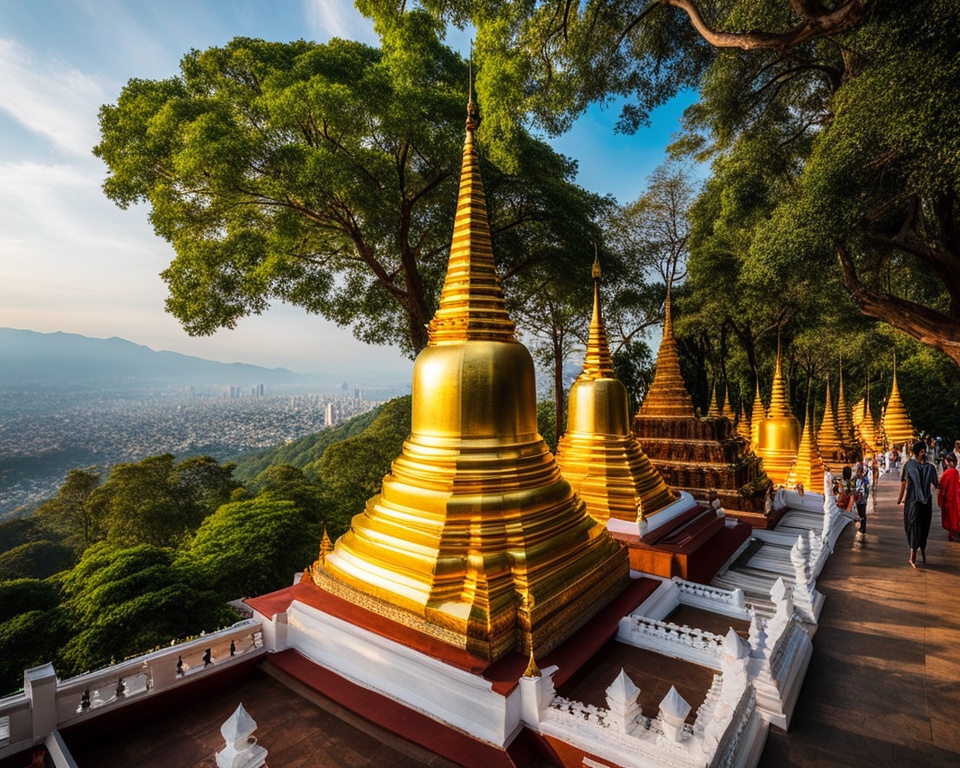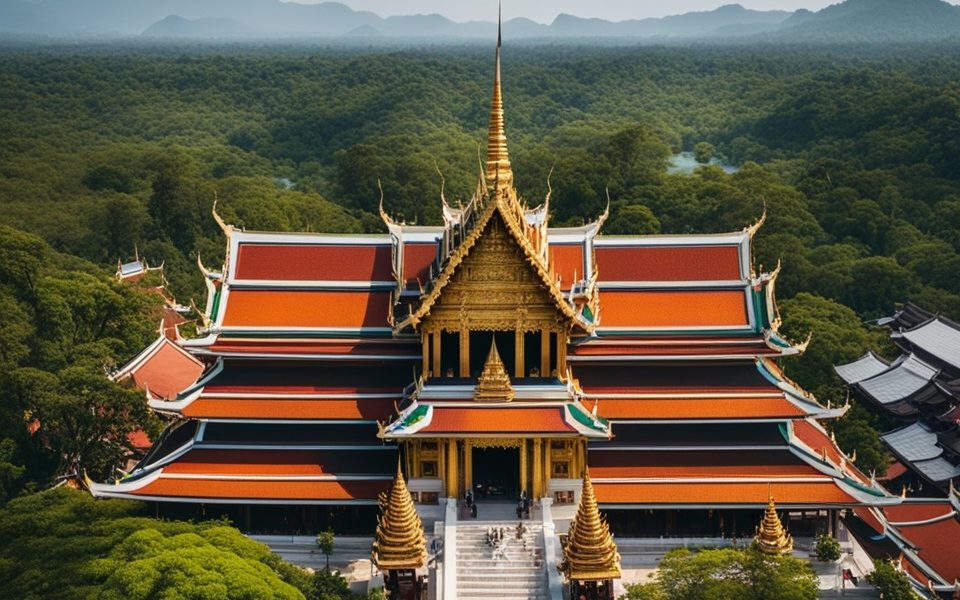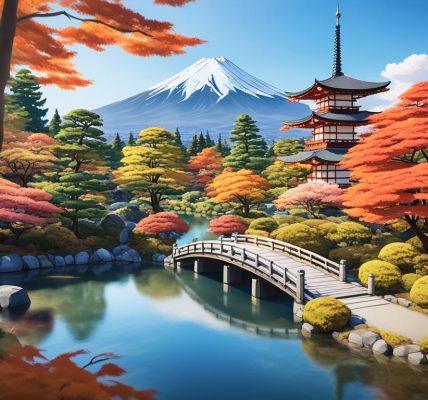Thailand is known for its rich culture, mainly its famous Buddhist temples, or “wats.” These sacred places show Thailand’s deep spiritual past and stunning architecture. Places like Wat Pho in Bangkok, Ayutthaya’s ancient ruins, and Chiang Mai’s peaceful Wat Phra That Doi Suthep call you to explore the heart of Thailand’s culture.
Everywhere you go in Thailand, you find these amazing temples. They are a big part of Thailand’s belief in Buddhism, and they draw people in from all over the world. The beauty, colors, and spiritual feelings at these temples will truly enchant you. Let’s dive into what makes Thailand’s key wats so special.
Read more interesting information at ::ds-collection
The Allure of Thai Temples
Thai temples, or “wats,” go beyond just being buildings. They are key spiritual and cultural spots that have fascinated people for ages. Serving as the soul of Thailand’s Buddhism, they show off detailed designs. These designs mirror the deep faith of Thailand’s people.
Thailand’s Spiritual Heartbeat
Thai Buddhist temples are hubs for both worship and art. They range from the impressive Bangkok temples to the peaceful Chiang Mai wats. Each temple reflects Thailand’s diverse cultural history in a special way.
Architectural Wonders of Faith
Thai temple architecture highlights the country’s strong spiritual roots. With fine details and bold colors, these structures draw visitors in. They offer a glimpse of something divine and inspiring.
“Thai temples are living entities that capture the nation’s soul.”
When you visit Bangkok temples or Chiang Mai wats, you dive deep into Thailand’s spirit. It’s an arresting journey that vividly showcases the country’s rich spiritual and cultural past.
Bangkok’s Iconic Wats
Bangkok, the lively capital of Thailand, is known for its stunning temples. One of its most famous is Wat Pho, the Temple of the Reclining Buddha. It holds a giant 46-meter-long golden statue of Buddha, bringing a sense of calm to all.
Wat Pho: The Temple of the Reclining Buddha
Wat Pho is centrally located in Bangkok. It’s a top place to explore Thailand’s deep culture. A huge golden Buddha lies there, creating a peaceful scene.
The temple is filled with detailed art, showing off Thai craft. Its beauty is inspiring and historic.
“Wat Pho is a true testament to the enduring spirit of Thai Buddhism. The serene atmosphere and magnificent architecture inspire a sense of reverence and contemplation in all who visit.”
Besides the reclining Buddha, Wat Pho has much more to offer. It has many Buddha statues and is home to a Thai massage school. There’s also a beautiful 19th-century pavilion, the Phra Maha Chedi Cluster, to see.
This temple complex is huge, with chapels, courtyards, and lush gardens. Bangkok temples are rich in history and culture, making them worth the visit.
For travelers, seeing Wat Pho is unforgettable. It mixes spiritual values, stunning design, and cultural history. This wat pho adds charm to Bangkok’s temple scene.
Wat Arun: The Temple of Dawn
Wat Arun sits beautifully by the Chao Phraya River in Bangkok. It’s known for its stunning design. People worldwide are amazed by its beauty.
The main feature is a tall spire called a prang. It reaches 79 meters into the sky. This structure is full of details and covered in shiny tiles. You can climb its steep steps for an amazing view.
This temple is full of meanings. The main spire represents a sacred mountain in Buddhist beliefs. Surrounding it are four smaller towers. They show the four main compass directions, adding to its beauty.
When the morning sun touches Wat Arun, it looks magical. That’s why it’s called the “Temple of Dawn.” People of all ages love to visit this special place to feel its peaceful vibes and see its charm.
“Wat Arun is a true masterpiece of Thai architecture, blending intricate details with a commanding presence that captivates all who behold it.”
If you like great architecture or quiet spots, visiting Wat Arun is a must. It’s a key part of Bangkok’s cultural scene.
Ayutthaya: The Ancient Capital’s Ruins
Ayutthaya, an ancient city, used to be the Siamese Kingdom’s capital. Today, it’s a UNESCO World Heritage Site. Known for its grand Ayutthaya ruins, it lets visitors see the old Thai Buddhist temples.
These temples show the kingdom’s past greatness and how Buddhism is important in Thai culture.
Exploring the Remnants of a Glorious Past
Visiting the Ayutthaya Historical Park feels like time travel. You see ruins of temples, palaces, and monasteries. They tell tales of the past’s grandeur.
Walking among the old stones and bricks, you admire the detailed carvings. This shows the deep cultural history of the region.
The Wat Phra Si Sanphet is a famous site there. It had a big golden Buddha statue. Even though the statue is no longer there, the three chedis remain. They give a sense of the temple’s former splendor.
| Highlight | Description |
|---|---|
| Wat Phra Si Sanphet | A former royal temple that once housed a towering golden Buddha statue. |
| Wat Chaiwatthanaram | A temple complex featuring a large central chedi surrounded by smaller satellite chedis and the remains of monastic buildings. |
| Wat Mahathat | Known for the iconic Buddha head entwined in a tree, a testament to the power of nature reclaiming the ruins. |
Exploring these ruins leaves visitors in awe of history. They see how the temples have stood strong through time. The ruins remind us of the area’s rich history and the Siamese Kingdom’s lasting impact.
“The ruins of Ayutthaya stand as a testament to the once-mighty Siamese civilization, a reminder of the transience of human endeavor and the power of nature to reclaim what was once its own.”
Sukhothai Historical Park: The Cradle of Thai Civilization
In the north of Thailand, you’ll find the Sukhothai Historical Park. It is a UNESCO World Heritage Site, honoring Thailand’s birth as a civilization. The park is a vast area filled with the artistic and architectural wonders from the Sukhothai Kingdom. It gives a wonderful look into the deep cultural history of the area.
The main attraction is the Wat Mahathat, a massive temple complex. It shows off the amazing work of the Sukhothai craftsmen. Here, visitors can see detailed stone carvings, large Buddha statues, and calm ponds. These all show how important Thai Buddhist temples are to the culture.
“Sukhothai is a true gem, a place where the past and present converge, inviting us to immerse ourselves in the timeless beauty of Thailand’s cultural legacy.”
But that’s not all in the Sukhothai Historical Park. There are many other well-kept temple areas to explore. Each one tells a unique story about the region’s history. Visitors can enjoy the peaceful surroundings and look at the detailed carvings and statues from the Sukhothai period.
The park is so important both architecturally and historically that it’s on the UNESCO World Heritage List. This makes it a place not to miss for those who want to learn about the cradle of Thai civilization. It’s perfect for history lovers, those who enjoy different cultures, and people in love with nature. The Sukhothai Historical Park is an experience that leaves a lasting impression. It helps everyone appreciate Thailand’s interesting and vivid past more.
Chiang Mai’s Northern Charm
In the middle of Northern Thailand, Chiang Mai wins over all who visit. It’s famous for its mountain temples, such as the must-see Wat Phra That Doi Suthep. This important temple sits on Doi Suthep mountain, giving breathtaking views of the city and greenery. It’s a key spot for Buddhists making a pilgrimage in Thailand.
Wat Phra That Doi Suthep: The Mountain Temple
To reach the grand Wat Phra That Doi Suthep, climb 309 steps or hop on a tram. It’s a key highlight among the many chiang mai wats, hailing from the 14th century and holding a sacred Buddha relic. The temple’s gold chedi and detailed designs show off Thailand’s deep culture.
Don’t miss wandering the temple’s sacred spaces and catching its great views. You’ll see worshippers doing their daily prayers, hoping for blessings and wisdom at this respected wat phra that doi suthep.
“The journey to the top of Doi Suthep is as much a part of the experience as the temple itself. The spectacular views and the sense of serenity make it a must-visit destination in Chiang Mai.”
Next to the main temple, the Wat Phra That Doi Suthep area also includes other shrines, columns, and a museum. Dive into its peaceful vibes and explore the temple’s spiritual value. It’s a major historical and spiritual symbol in Northern Thailand.

famous temples in thailand
Thailand has many famous temples that share its Buddhist beliefs. Each one is unique, showing the beauty of Thai culture and its spiritual side.
Bangkok has grand wats, like Wat Pho with its Reclining Buddha, and Wat Arun, known as the Temple of Dawn. The ancient capital Ayutthaya has temple ruins that are now a UNESCO World Heritage Site, telling of its glorious history.
In the north, Chiang Mai stands out with temples like Wat Phra That Doi Suthep. This mountain temple not only has stunning views but also showcases the area’s spiritual history. Everywhere you go, you’ll find famous temples in thailand leave a lasting impression with their beauty and stories.
| Famous Temples in Thailand | Location | Highlights |
|---|---|---|
| Wat Pho | Bangkok | Reclining Buddha, Thai massage school |
| Wat Arun | Bangkok | Stunning architecture, riverside location |
| Wat Phra That Doi Suthep | Chiang Mai | Mountain temple, panoramic views |
| Ayutthaya Historical Park | Ayutthaya | UNESCO World Heritage Site, temple ruins |
These famous temples in thailand are just a glimpse of the country’s spiritual culture. Exploring them, whether in Bangkok or the quiet of the north, opens a door to Thailand’s rich and diverse history.
Phuket’s Big Buddha: A Coastal Marvel
The phuket big buddha is perched on Nakkerd Hills in Phuket, Thailand. It symbolizes the island’s deep spiritual roots. This white marble figure stands tall at 45 meters (148 feet). It gives an awe-inspiring view of Phuket’s shores and calm beauty.
Both local worshipers and global adventurers hold the phuket big buddha in high regard. Its quiet vibe and grand size draw many visitors. It’s a top spot in South Thailand. People can walk up a spiral staircase to meet the Buddha, marvel at its details, and show respect.
“The phuket big buddha is a true marvel of craftsmanship and spirituality, standing as a symbol of Thailand’s enduring faith and cultural heritage.”
The big project started in 2002 and finished in 2017, with the help of the Mingmongkol Foundation and donations from here and around the world. The figure is crafted from white marble from Burma. It’s known for its pureness and lasting quality, ensuring the phuket big buddha will captivate hearts for years to follow.
The temple grounds include more than the striking statue. There are smaller holy places, spots for quiet reflection, and a place to learn about Phuket’s Buddhist legacy. Here, visitors can wander, join in sacred rituals, and enjoy a sense of peace near the ocean.
The Art of Thai Temple Architecture
Thai buddhist temples in Thailand are not just buildings. They are beautiful and meaningful works of art. These temples show the deep culture and strong beliefs of the people. Visitors are amazed by the special roofs, called “prasat,” and the beautiful decorations all around.
Intricate Designs and Symbolism
Every part of a Thai temple, like the figures on the roof and the detailed walls, has a special meaning. The roofs, for example, are more than just protection from rain. They show different levels of heaven. The highest point stands for the gods’ world.
Inside the temples, you’ll see carvings that tell stories of the Buddha’s past lives, known as the Jataka tales. These stories are more than decorations. They also teach the important beliefs of Buddhism, which is the main religion in Thailand.
| Architectural Element | Symbolic Meaning |
|---|---|
| Prasat Roof | Hierarchy of celestial realms in Buddhist cosmology |
| Mythical Creatures | Depictions from Buddhist legends and mythologies |
| Intricate Patterns | Visual representation of Buddhist teachings and beliefs |
Thai temples show the country’s deep culture and the power of their Buddhist faith. They are not just pretty buildings. Everything in these temples has a meaning. This makes visiting them a special and meaningful experience.
“The architecture of Thai temples is a magnificent interplay of form and function, where every detail is imbued with profound spiritual significance.”
Cultural Immersion and Etiquette
Visiting Thai Buddhist temples opens a door to the deep culture of Thailand. It goes beyond just seeing the buildings. It’s about connecting with their spiritual meaning. This means understanding and following the rules for visiting temples.
Dress modestly by covering your shoulders and knees. Before going in, always take off your shoes. This shows respect for the temple. While inside, be quiet and move slowly, so you don’t disturb others or show disrespect.
- Dress modestly, covering shoulders and knees
- Remove shoes before entering the temple grounds
- Move with a calm and reverent demeanor
- Speak softly and avoid disruptive behavior
Following these rules doesn’t just respect Thai customs. It helps you connect with the temple’s spiritual power. This way, you’ll learn more about Thailand’s deep traditions and beliefs.
“The true voyage of discovery consists not in seeking new landscapes, but in having new eyes.”
– Marcel Proust
Exploring Thai Buddhist temples is a chance for cultural growth. It allows you to step into a different world. By embracing this experience, you connect with the beauty of Thai culture. It broadens your perspective and helps you understand Thailand better.
| Etiquette Guidelines for Visiting Thai Temples | Importance |
|---|---|
| Dress modestly, covering shoulders and knees | Shows respect for the sacred nature of the space |
| Remove shoes before entering the temple grounds | Prevents dirt and impurities from being brought into the temple |
| Move with a calm and reverent demeanor | Maintains the serene atmosphere and respects the spiritual significance |
| Speak softly and avoid disruptive behavior | Ensures a peaceful environment for prayer and meditation |
Spiritual Significance and Festivals
Thai temples are deeply important to the people, acting as the center of Thai Buddhist traditions and cultural activities. These sacred places welcome everyone to join in their many festivals and rituals. This lets visitors get a deep look into Thailand’s lively Thai Buddhist legacy.
Celebrating Thai Buddhist Traditions
From the famous Songkran festival to the peaceful Magha Puja Day, these events are a special chance to be part of Thai Buddhist culture. They not just remember the Buddha’s lessons but also bring the community closer in faith and respect.
- The Songkran festival, Thai New Year, is bustling, with people pouring water to cleanse and refresh, over the Buddha and each other.
- Magha Puja Day celebrates when 1,250 enlightened monks came to see the Buddha without a special invite, marked with calm rituals at Thai Buddhist temples.
- The Loy Krathong festival features floating baskets with flowers and lit candles, showing respect to the water goddess and asking for forgiveness.
These festivals keep the spiritual significance of Thai Buddhist traditions alive. They also help the community unite, enjoy the festivities, and grow closer to the divine.
“Thai temples are not just physical structures; they are the beating heart of our spiritual and cultural identity.”
Thai Buddhist temples and their festivals highlight how the faith is key to Thai life. These holy sites and events create a link between the divine and us, inviting all to learn more about Thai Buddhist traditions.
Sustainable Tourism and Temple Conservation
More and more people worldwide are visiting Thai temples. This has led to a bigger focus on taking care of these cultural jewels. People are working hard to preserve these sites, encourage responsible visits, and teach travelers to respect their history. Sustainable tourism efforts aim to keep Thailand’s temple legacy alive for the next generations.
Keeping the balance between visitors and temple upkeep is key. There are rules to limit how many people can visit and to protect fragile areas. The use of eco-friendly ways to get around is also encouraged. Money made from these efforts goes back into caring for the temples. This helps ensure the temples can be enjoyed in the future.
In Thailand, temple conservation is a blend of old and new methods. Skilled craftspeople repair ancient carvings and art. They also train others to do the same. High-tech tools and eco-friendly techniques are used to lessen damage from the environment and people.
Teaching visitors about the temples’ cultural importance and how to behave there is vital. They are asked to dress modestly, take off their shoes, and be quiet. Learning about these places can make visitors care more about protecting them.
With more people wanting to visit, it’s crucial to use sustainable tourism in Thailand. This helps keep the country’s Buddhist temples true to their spirit and lets visitors enjoy them responsibly.

| Sustainable Tourism Initiatives | Temple Conservation Strategies |
|---|---|
|
|
“By embracing sustainable tourism, we can ensure the longevity of Thailand’s renowned temple heritage for generations to come.”
Preserving Thai temples is not just about culture. It’s a big part of making tourism sustainable. With careful visits and conservation, Thailand can show off its temples without damaging them. This way, these treasures can be enjoyed by future visitors.
Conclusion
Thailand’s temples stand as more than just buildings. They represent the nation’s deep spiritual and cultural roots. Visitors are drawn to places like Wat Pho in Bangkok or the peaceful sites of Chiang Mai. Each site provides a unique insight into Thai Buddhist ways.
These locations are windows into Thailand’s past and its dedication to preserving tradition. The famous temples in Thailand showcase the country’s strong ties to its culture and religion.
The serene beauty of these temples captures hearts and minds. They leave visitors feeling a part of Thailand’s unbreakable spirit. A spirit that echoes throughout the ages, kept alive by the noble temples.




